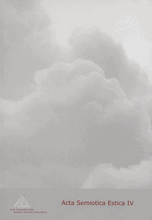Karl Ristikivi “Põleva lipu” leitmotiividest
On the leitmotifs of “The Burning Banner” by Karl Ristikivi
Author(s): Eva LepikSubject(s): Semiotics / Semiology
Published by: Eesti Semiootika Selts
Keywords: Karl Ristikivi; historical novel; the mythic; motifs; Karl Ristikivi; ajalooliste romaanide tsükkel; müüdilisus; motiivianalüüs
Summary/Abstract: The present article analyses the leitmotif structure of the historical novel “The Burning Banner” (1961) by the Estonian writer Karl Ristikivi. The novel commences a 12-volume series of novels on European history setting the course and remaining the key text of the series. The method of analysis used is Boris Gasparov’s induction of ideas that considers text dual-natured: a text is simultaneously a hermetic coherent artefact as a whole and an open accumulator of the flowing continuum of cultural memory and experience. Using Gasparov’s method, the component ideas from different levels of the text are associated and the functions of these relations in creating the artistic unity of the text are elucidated. The method presumes an open approach to the logic of motif development and asserting induced meanings in order to show how motifs are intertwined in the semantic configurations of the work and determine the positions of the said motifs. The article charts the underlying mythic structure of “The Burning Banner” as well as the hidden layers of meaning of the novel. The mythic and hidden intertextual themes analysed in the novel include: • historical events projected onto Biblical events (identifying the protagonist, the last Hohenstaufen Conradin, with king Solomon of the Old Testament and projecting various episodes of his campaign in Italy onto the Passion of Christ) • implicit and explicit occurrences of the axis mundi motif as well as its transformations (tree, mountain, temple) in the structure of the work and • the intertwined motifs of Doppelgängers of the protagonist as birds.
Journal: Acta Semiotica Estica
- Issue Year: 2007
- Issue No: 4
- Page Range: 175-194
- Page Count: 20
- Language: Estonian

